Apple iPhone 4S: Thoroughly Reviewed
by Anand Lal Shimpi & Brian Klug on October 31, 2011 7:45 PM EST- Posted in
- Smartphones
- Apple
- Mobile
- iPhone
- iPhone 4S
Faster Throughput on WCDMA
Fixing unintended attenuation is only one part of what’s new however, the other part of the story is faster cellular connectivity for users on WCDMA/UMTS carriers. Users who are using the 4S on CDMA (like Sprint or Verizon) won’t see a performance difference since this is still the same EVDO Rev.A.
The iPhone 4 used an Intel/Infineon X-Gold 618 which supported HSDPA 7.2 and HSUPA 5.76. The MDM6610 inside the 4S supports HSDPA 14.4 and HSUPA 5.76, alongside a number of 3GPP Rel.7 features which are colloquially known as HSPA+. I talked about this extensively in another piece when there was some confusion about whether or not the 4S is HSPA+ - which it is.
| iPhone Cellular Speeds | ||||
| Property | iPhone 3G/3GS | iPhone 4 (GSM/UMTS) | iPhone 4 (CDMA) | iPhone 4S |
| Baseband | Infineon X-Gold 608 | Infineon X-Gold 618 | Qualcomm MDM6600 | Qualcomm MDM6610 |
| HSDPA | Cat.8 - 7.2 Mbps | Cat.8 - 7.2 Mbps | N/A | Cat.10 - 14.4 Mbps |
| HSUPA | None - 384 Kbps WCDMA only | Cat.6 - 5.76 Mbps | N/A | Cat.6 - 5.76 Mbps |
| EVDO | N/A | N/A | 1x/EVDO Rev.A | 1x/EVDO Rev.A |
The previous X-Gold 618 baseband was a nice improvement over the iPhone 3G/3GS’ X-Gold 608, which lacked HSUPA, but in a world where most WCDMA carriers are at least running HSDPA 14.4, it’s nice to finally have an iPhone with something faster than HSDPA 7.2. I’ve done lots of testing inside my Tucson, AZ market (which is “4G” HSPA+ on AT&T’s coverage viewer) with both the 4 and the 4S, and have built a very good feel for the 4’s performance. As a reminder, if you’re in the USA, those dark blue areas represent HSPA+ coverage areas with AT&T’s upgraded backhaul. In practice these are at least HSDPA 14.4.

Left: iPhone 4 Limited to ~6.1 Mbps down, Right: iPhone 4S (same location) hitting ~9 Mbps
With line of sight to an AT&T NodeB inside my HSPA+ market I’m used to seeing a maximum downstream throughput on the iPhone 4 of almost exactly ~6.1 Mbps, which is about right for the 4’s HSDPA 7.2 maximum when you include overhead. The nice straight line in that result should clue you in that downstream throughput on the 4 was being gated by the baseband. On the 4S, in this same location, I’ve been able to get 9.9 Mbps when the cell isn’t loaded at night (I didn't grab a screenshot of that one, for some reason). It’s nice to finally not be gated by the baseband anymore on an iDevice. Having a faster baseband is part of the reason the 4S’s cellular performance is much better, the other half is receive diversity which helps the 4S push these high throughput rates, and also dramatically improve performance at cell edge.
I did some drive testing with the 4 and 4S side by side and targeted areas that I know have pretty poor signal strength. The 4S is shown in yellow, the 4 in blue.
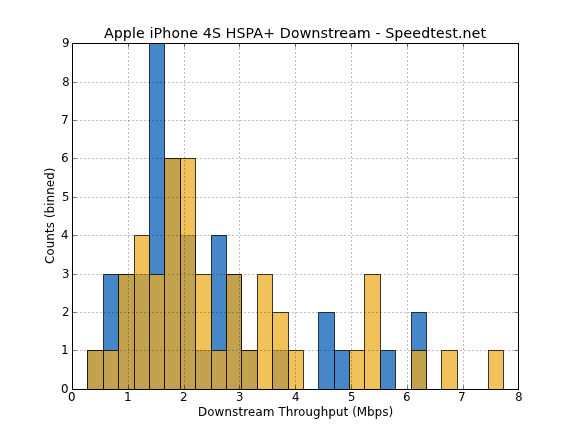
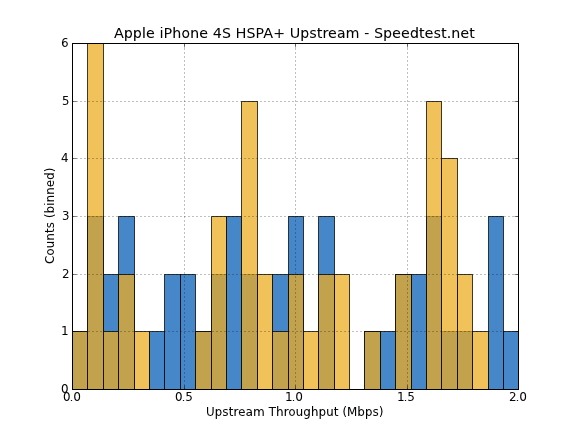
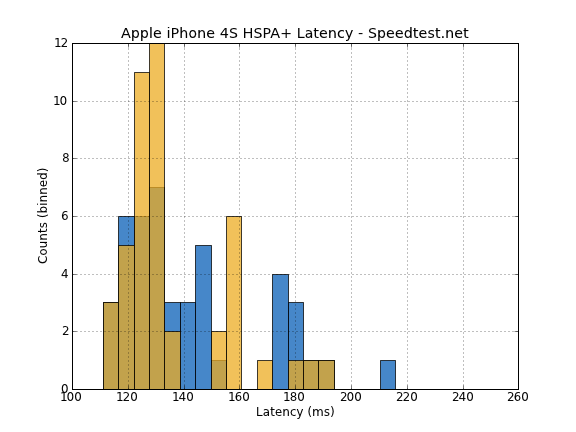
You can see how downstream throughput gets a nice shift up, and the average changes as well, from 2.28 Mbps on the 4 to 2.72 Mbps on the 4S. The maximum in this sample increases from 6.25 to 7.62 Mbps as well. It isn’t a huge shift, but subjectively I’ve noticed the 4S going a lot faster in areas that previously were difficult for the 4.
We’ve also run the usual set of standalone tests on the 4S on AT&T in my market of Tucson, AZ, in Anand’s market of Raleigh, NC, and on Verizon in Raleigh, NC. Though we don’t have a Sprint 4S yet, we hope to do a more serious 4S carrier comparison here in the US when we get one. First up is AT&T which is of course HSPA+ in both of our testing markets.
AT&T HSPA+
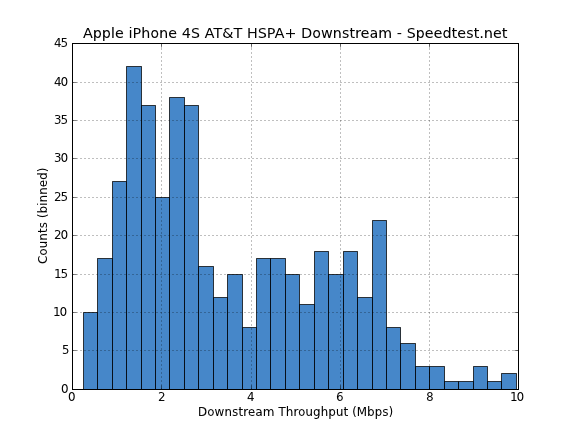
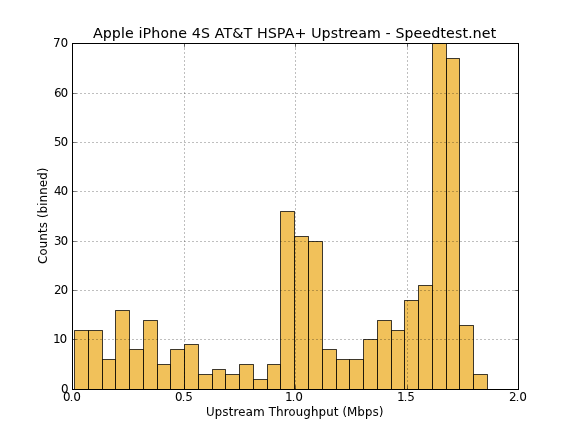

Verizon EVDO
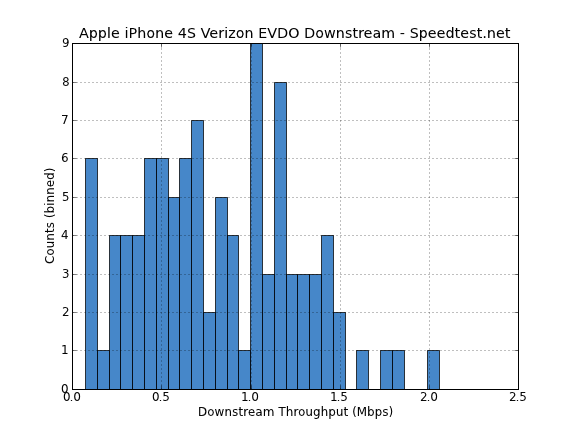
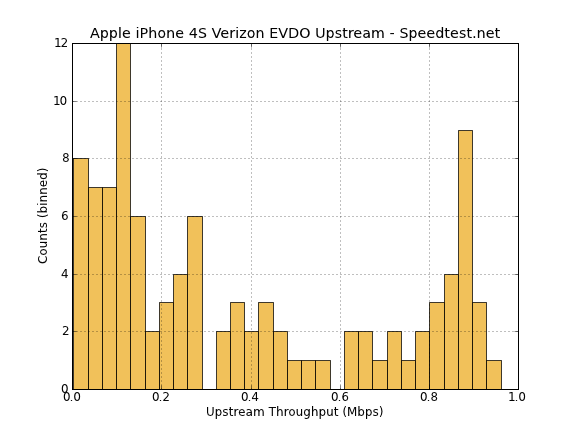

| iPhone 4S Speedtest Comparison | ||||||
| Carrier | AT&T | Verizon | ||||
| Avg | Max | Min | Avg | Max | Min | |
| Downstream (Mbps) | 3.53 | 9.94 | 0.24 | 0.82 | 2.05 | 0.07 |
| Upstream (Mbps) | 1.17 | 1.86 | 0.009 | 0.38 | 0.96 | 0.003 |
| Latency (ms) | 137 | 784 | 95 | 177 | 1383 | 104 |
| Total Tests | 457 | 150 | ||||
| Air Interface |
HSPA+ (HSDPA 14.4/HSUPA 5.76) |
EVDO Rev.A | ||||
For the CDMA carriers, the 4S shouldn’t (and doesn’t) bring any huge improvement to data throughput because the CDMA 4 had both receive diversity and MDM66x0. For users on GSM/UMTS, however, the 4S does make a difference again thanks to the inclusion of those two new features.
One of the things I noticed was absent on the CDMA iPhone 4 was the 3G toggle. It does indeed make some sense to not include this in a CDMA 1x/EVDO scenario since power draw is about the same between the two air interfaces, however, the absence of this toggle has carried over to the 4S regardless of whether the phone is activated on a CDMA2000 or UMTS/GSM network. That’s right, you can go under Settings -> General -> Network, and there’s no longer any 3G Data toggle which you can disable and fall onto EDGE (2G) with now.
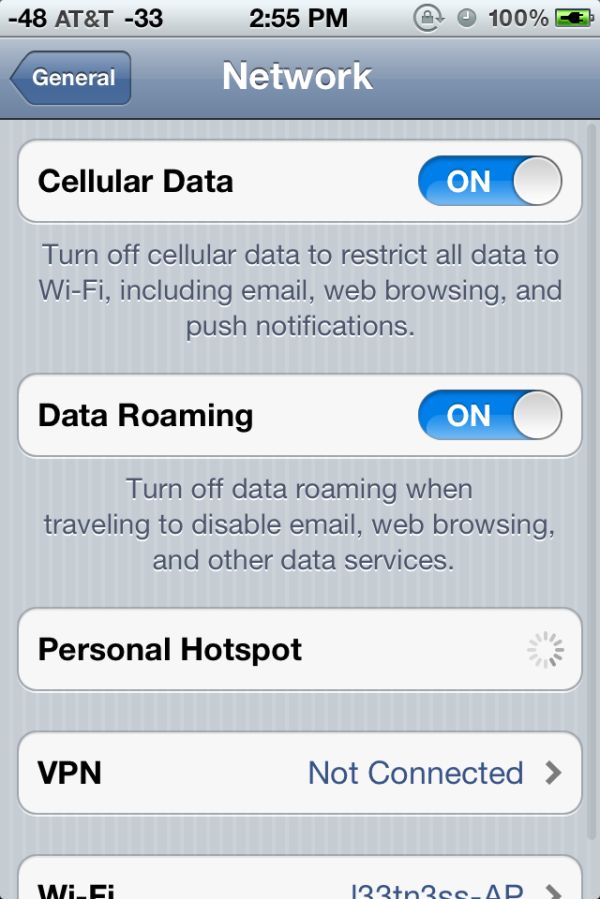
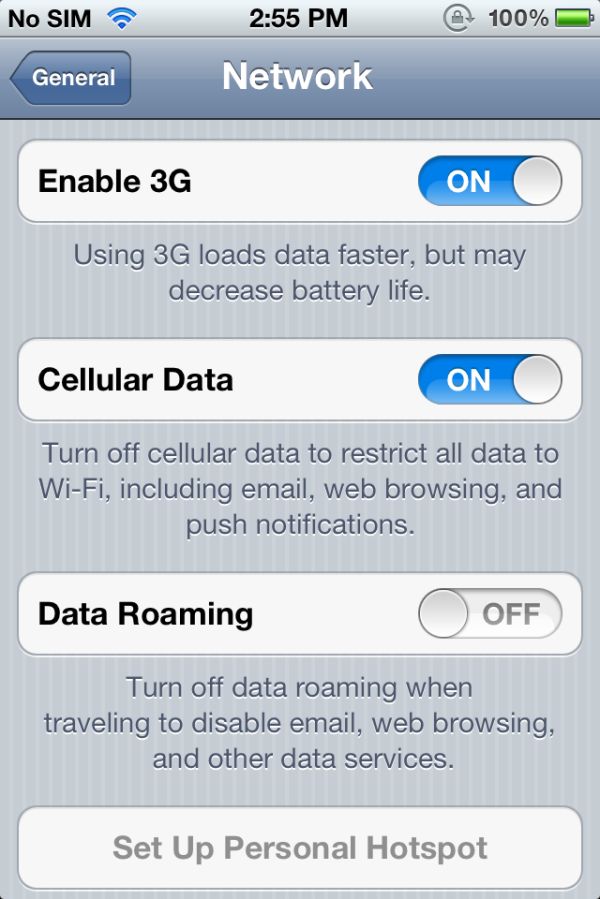
Left: iPhone 4S (no 3G toggle), Right: iPhone 4 (3G toggle)
It’s likely that this is absent to accommodate the multi-mode nature of the 4S (and thus the lowest common denominator CDMA mode), however the absence of this toggle makes getting connected in congested areas more difficult. In some markets, (I’m looking at you, AT&T in Las Vegas), EDGE is often the only way to get any connectivity, even without a major convention going on. Not having that 3G toggle makes manually selecting that less-used but more reliable connection impossible now, to say nothing of the potential battery savings that this would afford (and that we sadly can’t test now).
There’s one last tangential question about HSPA+ on the 4S, specifically on AT&T. I’ve left this to the end since it doesn’t impact non-US 4S users, but the last question is whether the 4S is actually on HSPA+. For a while, I was concerned that AT&T would continue using the wap.cingular APN on the 4S which seems shaped to around 7.2 Mbps HSDPA. I’m glad to report that AT&T hasn’t continued using wap.cingular on its 4S data plans, instead using “phone” which is a newer APN that allows for HSPA+ (above 7.2 Mbps) rates. You can check this yourself under PDP Context Info on the 4S in field test.


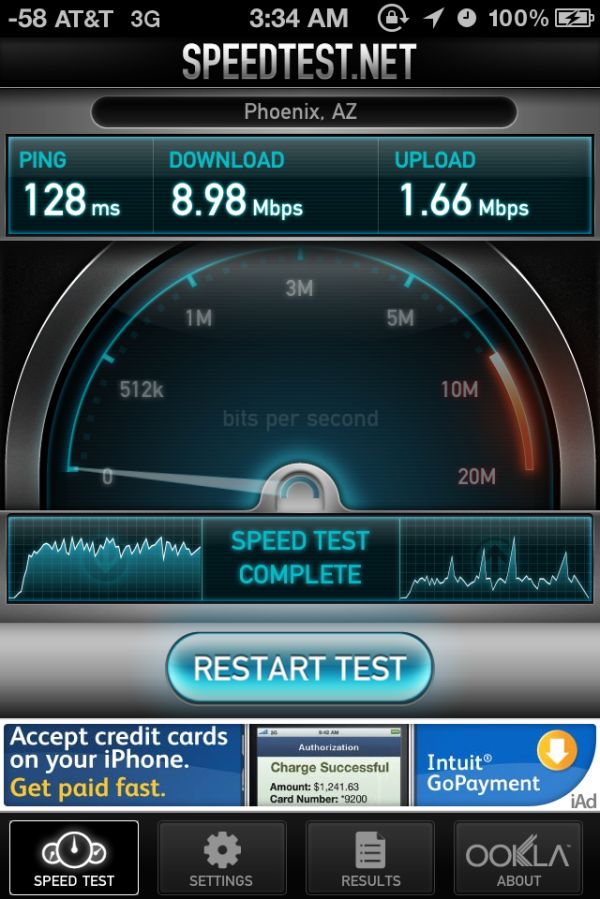
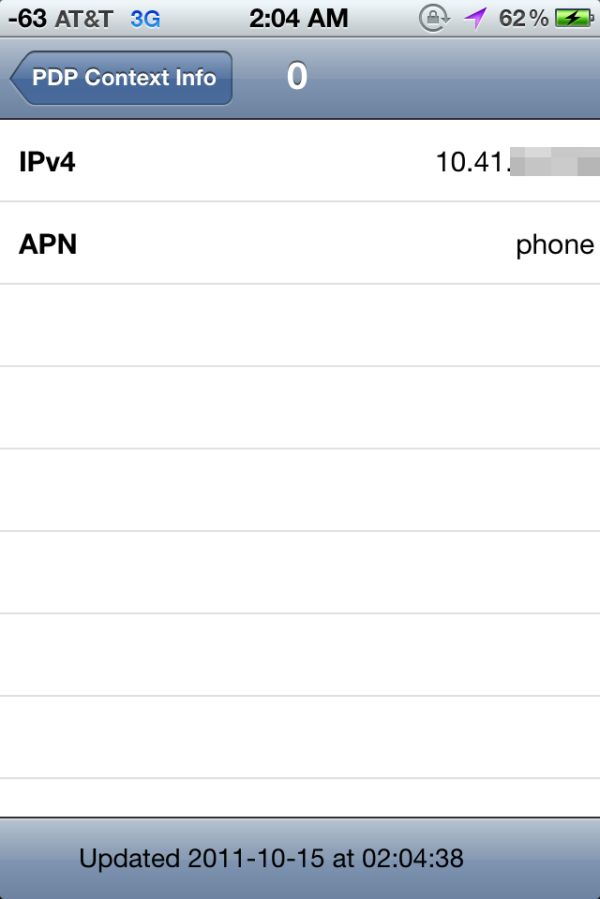








199 Comments
View All Comments
medi01 - Thursday, November 3, 2011 - link
Find contrast of BEAUTIFUL Galaxy phones on the charts pretty please...doobydoo - Friday, December 2, 2011 - link
Yeah the 'beautiful' screens...The Galaxy screen is what, 480 x 800? on a 4.27 inch screen?
The iPhone 4s is 640 x 960 - on a 3.5 inch screen.
A much higher resolution.
Brian Klug - Sunday, November 6, 2011 - link
"1) Ridiculous BS sentences about "improved vibration" that obviously come straight out of Apple's marketing mouth"I'm sorry you feel that way, but the vibration unit is indeed different, and lends a completely different feel from every other device out there which just uses a spinning counterweight.
I'd encourage you to try it on your own.
-Brian
Samus - Tuesday, November 1, 2011 - link
Great review, thanks Anand! If I weren't so stubborn I'd get an iPhone (because they really are great phones) but I just can't do the Apple thing. I like the openness, tweakability and choices provided by Android phones, but for the general population, the iPhone is pretty much the best option for the high-end market.zanon - Monday, October 31, 2011 - link
Hoorah, the definitive review is here at last! Thanks as always for your hard work on this.And yeah, the 543MP2 is a sick monster of a chip. Imagination Technologies really hit a home run with this one, simply amazing performance. Not just Apple either, I believe the Vita is using the MP4 version of this chip. With the show they've put on this time, I'm very much looking forward to seeing what they do for the Series 6 Rogue ones that I think are still due next year. Or for that matter even if they do an update/shrink of these ones.
Great to see so much competition between graphics in the mobile world, practically every major player has a foot in the water at least. I think this stuff will start to matter more and more too for items beyond games. Applications like further advances in augmented reality seem like they could use plenty of power, and are uniquely suited to mobile platforms. Things will get really nuts when retinal projection displays or some equivalent finally start filtering down into the main market.
Lucian Armasu - Tuesday, November 1, 2011 - link
It's not really about the architecture, though, but about the size of the GPU = more performance. It's 2x the size and has 1.5-2x the performance of Exynos' GPU. Not that surprising.I'm not entirely sure why they had to use such a powerful GPU, though. Is it to make it easier to support higher resolutions? Because it can't be about the games. Why would it get 7x the performance of the previous iPhone 4 GPU, when it can only use 2x of that anyway?
loganin - Tuesday, November 1, 2011 - link
That's a pretty weak and factually wrong claim to discredit Apple's product, not that it's surprising coming from you."Exynos SoC Same Size As Apple A5 In iPad 2"
http://www.itproportal.com/2011/06/07/exynos-soc-s...
zanon - Tuesday, November 1, 2011 - link
loganin already addressed your claptrap regarding size, so we'll just ignore that. A few other bits stand out, however. The first is that, fundamentally, even if you were right so what? You don't win any points for improving in one way vs another, what matters is the result at the end. Regardless of the method PowerVR used the fact that the 543MP2 utterly demolishes the competition, and that it's a beast, would not change.Second, you failed to mention in your "1.5x-2x" the performance bit the fact that it's also clocked *50% slower* then the Exynos. Again, even pretending you were correct, your size difference *still* wouldn't explain the kind of gap we're seeing. Unlike size, which is not perfectly correlated with performance, clock rate pretty directly is. If the 4S's A5 was running at 1.2 GHz, it would be more like 2.8x the performance of the Exynos at the high end.
>>Because it can't be about the games. Why would it get 7x the performance of the previous iPhone 4 GPU, when it can only use 2x of that anyway?
Also, this bit is just WTF. You might have noticed that PC GPUs continue to increase in power? Despite resolutions not continuing to increase? WTF do you mean "you can only use 2x of that"?? At least until the level of complete photorealism with full real time physics modeling of everything is achieved there's always room to spend more power just making the scene look better. Duh.
metafor - Tuesday, November 1, 2011 - link
Erm, GPU clocks are independent of what the CPU is clocked at. I.e. just because the A5's CPU is clocked at 800MHz doesn't mean the GPU is.Apple never really releases what the internal clocks of their various components are running at.
Lucian Armasu - Wednesday, November 2, 2011 - link
Do you even know what 50% slower means? It means half the clock speed. It's not 50% slower. It's 30% slower than Exynos CPU.. It's the Exynos CPU that is "50% faster" than the A5 one.But that's not even what we were talking about. I was talking about the GPU, not the CPU. The GPU has a difference frequency.